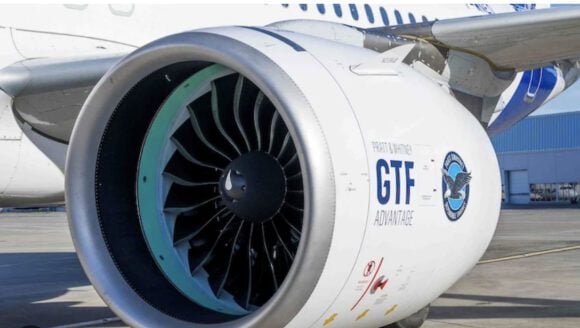Last Thursday, a Pratt & Whitney PW1500 geared turbofan engine had a major failure that was partially contained. The engine failure damaged the engine nacelle and fuselage of the CSeries test aircraft FTV1, with no apparent damage to the wing nor any fuel leaks. The engine, the oldest engine in service in the Bombardier fleet, was undergoing routine ground maintenance testing at the time, with both engines on the airframe, which was held in a static position, running. Bombardier has suspended its flight test program pending the results of an investigation of why the engine failed by Pratt & Whitney.
 The investigation by Pratt & Whitney has begun, and the subject engine has already been transported from Mirabel Airport north of Montreal, where the incident occurred, to the company’s facilities in East Hartford, Connecticut. It is too early to speculate as to the cause and severity of the problem. The GTF engine program has completed more than 9,000 hours of testing, including 1,300 hours in flight.
The investigation by Pratt & Whitney has begun, and the subject engine has already been transported from Mirabel Airport north of Montreal, where the incident occurred, to the company’s facilities in East Hartford, Connecticut. It is too early to speculate as to the cause and severity of the problem. The GTF engine program has completed more than 9,000 hours of testing, including 1,300 hours in flight.
Aircraft engines undergo rigorous testing, both by the engine manufacturers and airframe manufacturers prior to entry into service. As one of the objectives of testing is to push the engine to its limits, apparently one limit may have been found. This is not the first, nor likely to be the last time that an engine fails during a flight test program.
The GEnx engine on the Boeing 787 experienced a failure during taxi testing in South Carolina during that program’s development. These types of failures occur routinely during testing, such as the diesel Cessna 182 failure last year. Engines can also fail in service, as was experienced when a Rolls-Royce engine on a Qantas A380 failed on an in-service passenger flight departing Singapore. The real question is how long it takes for the engine to be examined, the fault found, and resumption of flying to begin.
The Rolls-Royce experience at Qantas provides us an indication of the speed of the investigative process. In that case, with a similar partially contained failure, Rolls Royce was able to rapidly diagnose the problem, identify the root cause and provide a corrective repair kit to customers that resulted in re-entry into service in one month.
What will be the impact on CSeries program and EIS?
While it is too early to tell, we believe that Bombardier built in about six months of slack into their forecast of EIS in the second half of 2015. The result of this delay, unless it is protracted, should not impact meeting their broadly stated EIS target. At the IATA conference in Doha, Qatar, this morning, Bombardier Aerospace CEO Guy Hachey said “In any flight test program there will be things that will happen, and it is not unexpected that we will have some problems. We have factored that into our timeline and schedules so we can absorb (them).”
He went on to indicate that stationary testing of other systems, including the APU, avionics, and electrical systems is continuing while the aircraft are grounded, minimizing any loss of time. He also mentioned that Bombardier has called each of its CSeries customers, updating them on the incident shortly after it occurred. “They were very appreciative of getting a heads-up…and nobody cancelled” he said.
Despite assurances from Bombardier that EIS should not be impacted, it remains too early to tell until the cause of the incident is determined, and we expect more information to emerge during this week. Until we learn more about the nature of the engine failure, it is too early to speculate that there will or will not be a significant impact on EIS. But if past is prologue, this process may take a month or so of the slack built into the program. If everything else goes as planned, it shouldn’t be a problem, but should another problem emerge, the slack to accommodate it may disappear.
What does this mean for the GTF program?
The GTF program will provide power to five different aircraft programs, with the CSeries being the first to enter service, and farthest along in testing. We do not believe that this incident will have an impact on the other GTF programs, and PW is confident it will work with Bombardier to identify and correct the root cause of the problem.
This incident is unrelated to a recent incident with another GTF engine on April 29th. In that incident, a different GTF engine experienced an anomaly and caught fire, which was extinguished quickly. That root cause turned out to be a minor anomaly that was identified and corrected, and that engine resumed flying the next day. There is no relationship between that incident and the FTV1 engine failure.
We fully expect that PW, as GE and Rolls-Royce experienced, will discover the root cause of the problem and correct it within a relatively short period of time, and that no significant impact on the GTF program will result.
Views: 29





Better to fail during flight testing than in service.
That’s the whole purpose behind testing-to find failures BEFORE EIS!
Agreed. Better a fire on the ground that a sudden boom in the skies. This will probably push EIS beyond 2015. I’ll say mid 2016.
GE brings good things to life!
Putting gears in engine just adds more failure points. If you want the fan to spin slower add a cluster of electric motors in front and use the power unit to drive it. Gears just doesn’t make sense.